Smart Switches with a CAN Serial Communication Bus
Dow-Key Microwave Corp.
Ventura, CA
A new series of electromechanical switches has been developed that is targeted specifically at test equipment applications where fast system integration and system flexibility for modifying and extending switch layout are required. The unique switches are based on an ISO-defined serial communication bus and add tremendous flexibility to today s complex test systems. Only four wires per switch are required to control the unit and read indicator contact status. Complex switch matrices can be assembled without intermediate control circuitry requirements. A network of as many as 100 switches can be controlled by a PC using a standard, commercially available Controller Area Network (CAN) interface card. Programmable features include an identifier (switch address), switch initialization, set position error and pulse length.
The new switch series initially includes the model 411HC-480823A-1 double-pole double-throw (transfer) latching switch and the model 461H-480823A-1 single-pole six-throw (SP6T) latching switch with internal 50 W terminations. The transfer and SP6T latching switches have a maximum coil current of 180 and 250 mA, respectively, at 24 V and 20°C and operating voltage is 22 to 26 V DC. Switching time is 20 ms (max), the RF contacts are break-before-make and the operating mode is latching. Mechanical lifetime for both models is one million cycles and the operating temperature range is 0° to +65°C. Table 1 lists the RF characteristics for both switches.
|
Table 1 | ||||
|
Frequency |
SWR |
Isolation |
Insertion Loss |
Power Handling |
|
0 to 1 |
1.10 |
85 |
0.1 |
100 |
|
1 to 4 |
1.20 |
80 |
0.2 |
100 |
|
4 to 8 |
1.30 |
70 |
0.3 |
70 |
|
8 to 12 |
1.40 |
65 |
0.4 |
60 |
|
12 to 18 |
1.50 |
60 |
0.5 |
45 |
Details of the CAN interface include full compliance with CAN V2.0 Part B passive requirements, up to a 1 M-baud CAN bus transfer rate, an 11-bit CAN BUS arbitration identifier and a 29-bit extended identifier. The switches are ISO-11890 physical layer compliant and require 0.025 A quiescent current at 24 V DC. The in-system programming interface is ATMEL AVR MCU ISP compatible (ATMEL = the manufacturer of the microcontroller, AVR = family of reduced instruction set computer microcontrollers, MCU = micro-controller and ISP = in-system programming).
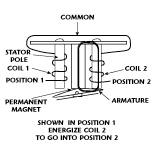 The Switch Actuator
The Switch Actuator
The switch actuator is a proven electromagnetic (EM) design currently employed in a majority of the company s coaxial switches. The operation of the actuator is shown in simplified form in Figure 1 . The position of the rotating armature assemblies is controlled by an EM circuit. A magnet is attached to the coil plate assembly and, when a DC voltage is applied to a coil, the two stator poles become polarized. The subsequent polar attraction and repulsion between the permanent magnet and the energized circuit result in rotational movement of the armature assembly. This design configuration allows the magnetic forces present in the energized circuit to be fully utilized. In both positions, the permanent magnet securely latches the armature assembly in place.
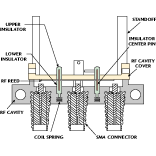 The RF Head Design
The RF Head Design
RF switching is accomplished by movement of RF conductor elements within a rectangular transmission line. The basic design of the RF head assembly is shown in Figure 2 . When actuated to the on position, the conductor element forms a 50 W transmission line, as shown in Figure 3 . In the selected RF position, each end of the actuated reed contacts the portion of the RF connector center conductors that extends into the RF cavity. The off-position conductor element is forced back into contact with the respective ground wall to form a single-ridge waveguide. Due to its geometry, the cutoff frequency of the waveguide is far above the operating frequency of the switch, thus allowing a high degree of isolation between on and off signal paths.
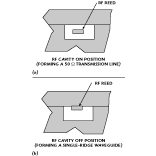 The movement of each reed in the switch is controlled by a mechanical linkage that transfers rotary motion of the armature into linear motion in the RF head. When the actuator is in transition from one position to another, the motion is transmitted to the conductor elements through small dielectric plungers. Each conductor element is firmly captured by guide pins.
The movement of each reed in the switch is controlled by a mechanical linkage that transfers rotary motion of the armature into linear motion in the RF head. When the actuator is in transition from one position to another, the motion is transmitted to the conductor elements through small dielectric plungers. Each conductor element is firmly captured by guide pins.
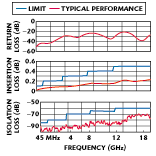 The materials and processes used in the construction of the RF head assembly or waveguide sections of the switches have been selected to provide consistently high RF performance. The RF reeds for the coaxial switch are manufactured from beryllium copper, which has the mechanical properties necessary to withstand the impact of repeated switching. The reed s gold plating allows for highly uniform RF performance and environmental resistance. Each cavity is machined from 6061-T651 aluminum, which is a high strength, lightweight alloy. The cavity has an external gold-plated finish and an internal chemical-film finish. This configuration offers the best compromise for RF performance and power handling capabilities.
The materials and processes used in the construction of the RF head assembly or waveguide sections of the switches have been selected to provide consistently high RF performance. The RF reeds for the coaxial switch are manufactured from beryllium copper, which has the mechanical properties necessary to withstand the impact of repeated switching. The reed s gold plating allows for highly uniform RF performance and environmental resistance. Each cavity is machined from 6061-T651 aluminum, which is a high strength, lightweight alloy. The cavity has an external gold-plated finish and an internal chemical-film finish. This configuration offers the best compromise for RF performance and power handling capabilities.
Figure 4 shows typical performance for the model 411HC-480823A-1 transfer switch from 45 MHz to 18 GHz. Figure 5 shows similar performance data for the model 461H-480823A-1 SP6T latching switch. Figures 6 and 7 show the switches respective outline drawings.
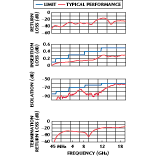 Applications
Applications
Typical applications for the CAN bus switches include automatic test equipment (ATE) where a switching network (switch matrix) is required to connect a multiport device under test to various types of test equipment. The switches allow the user to connect more than 100 switches to a matrix and control them from a standard PC. Any combination of the two described switches may be integrated into a controllable switching network that provides a total solution to the user s requirements. Such an integrated assembly consists of an array of SP6T and transfer switches interconnected for the user s specifications, a plug-and-play CAN interface card (including driver software with Windows® compatibility) and software allowing full control of the switch network using a standard PC.
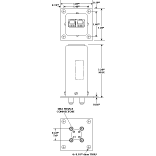 Free evaluation software that allows full control of a 6 x 6 matrix based on SP6T switches is available. The software allows the user to control switches and read status indicators. Building a 6 x 6 matrix requires a minimum of 12 SP6T switches, 36 semirigid cables for interconnection, a plug-and-play CAN interface card with driver software and a few other development tools (available from the company), a standard PC (minimum requirements of Windows 95 and 32 MB RAM) and CAN bus cables (available from the company). A smaller 4 x 4 matrix also can be used, provided the configuration is based on SP6T switches.
Free evaluation software that allows full control of a 6 x 6 matrix based on SP6T switches is available. The software allows the user to control switches and read status indicators. Building a 6 x 6 matrix requires a minimum of 12 SP6T switches, 36 semirigid cables for interconnection, a plug-and-play CAN interface card with driver software and a few other development tools (available from the company), a standard PC (minimum requirements of Windows 95 and 32 MB RAM) and CAN bus cables (available from the company). A smaller 4 x 4 matrix also can be used, provided the configuration is based on SP6T switches.
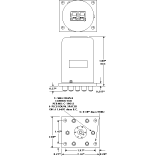 In addition to ATE, other applications using CAN bus switches are possible, specifically in applications where routing a number of inputs to a number of outputs with switching requirements is necessary. CAN bus switches can provide a cost-effective solution that drastically reduces development and system integration time. CAN bus switches also may be utilized as building blocks in redundancy matrices for complex systems with redundant power amplifiers and/or antennas. For more information, visit the company s Web site at www.dowkey.com.
In addition to ATE, other applications using CAN bus switches are possible, specifically in applications where routing a number of inputs to a number of outputs with switching requirements is necessary. CAN bus switches can provide a cost-effective solution that drastically reduces development and system integration time. CAN bus switches also may be utilized as building blocks in redundancy matrices for complex systems with redundant power amplifiers and/or antennas. For more information, visit the company s Web site at www.dowkey.com.
Dow-Key Microwave Corp., Ventura, CA (805) 650-0260.
